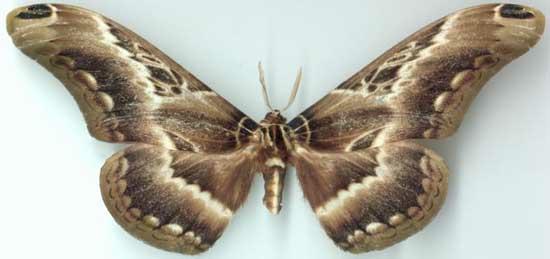Dactyloceras nebulosa
Brosch, Naumann, & Meister, 2002 (“2001”)


Dactyloceras nebulosa lacks the two fields of multiple, parallel, fine, dark fasciae on either side of the forewing medial zone. The parallel lines are also missing from the hindwings in nebulosa.
Little is know about larval hosts but Ceropegia in the Asclepiadaceae family (in the same order as the Oleaceae) is noted.
Dactyloceras nebulosa flies in mountainous regions of Cameroon, in the Yaóunde environment in May and June.
Forewing length of 86.5 mm, and antennae length of 17 mm are taken from a single known specimen. The dorsal and ventral ground color is a grayish ochreous brown with black and white markings similiar to D. lucina, but without any wavy lines both in dorsal and ventral view.
D. lucina always clearly shows the wavy lines in dorsal and ventral view, and even if some specimens exhibit them somewhat reduced in parts of the wing, no complete or major reduction was found.
In D. nebulosa the marginal part of the wing shows a bright light grayish brown area, getting gradually darker on the lower part of the forewing and on the hindwing; the central white marking is not bordered by a small dark line combined with a brighter zone of whitish ground coloring as in D. lucina.
The male genitalia of D. nebulosa are quite similar to those of D. lucina. Typical is a deeply bifid uncus with a lot of bristles, the transtilla is enlarged to a prominent lobe which is bifid dorsally. The sacculus of the valva is prominent, the internal ventral process has two small spines on its top, the dorsal lobe again with a lot of bristles. The aedeagus is long, tall, with the vesica emerging dorsally which has a small sclerotization medially.
Small differences to D. lucina are the less deep furcation of the uncus and the slightly more slender dorsal parts of the valva in this species. Due to the genitalia morphology D. nebulosa most likely may be closely related to D. lucina.
D. bramarbas has some totally different characters in male genitalia, such as the two longer processi of the uncus, the small transtilla with two lateral dentated processi, only one spine on the internal ventral process of the valva, a shorter aedeagus, and the generally smaller size.
D. nebulosa is known from a male singleton; the female remains unknown.
Etymology: the new species is named for its vapid phenotype; nebulosa is based on the Latin term ” nebulosus ” = foggy or misty.
of the highly variable D. lucina from different localities in Cameroon, Sierra Leone, Ghana, and Central African Republic. no syntope flying specimens of D. lucina are known. We suppose that biotopes of the latter one generally are at lower elevations whereas D. nebulosa comes from higher altitudes. After present knowledge D. bramarbas is a mountain species.
Return to Dactyloceras Index
Return to Main Brahmaeidae Index